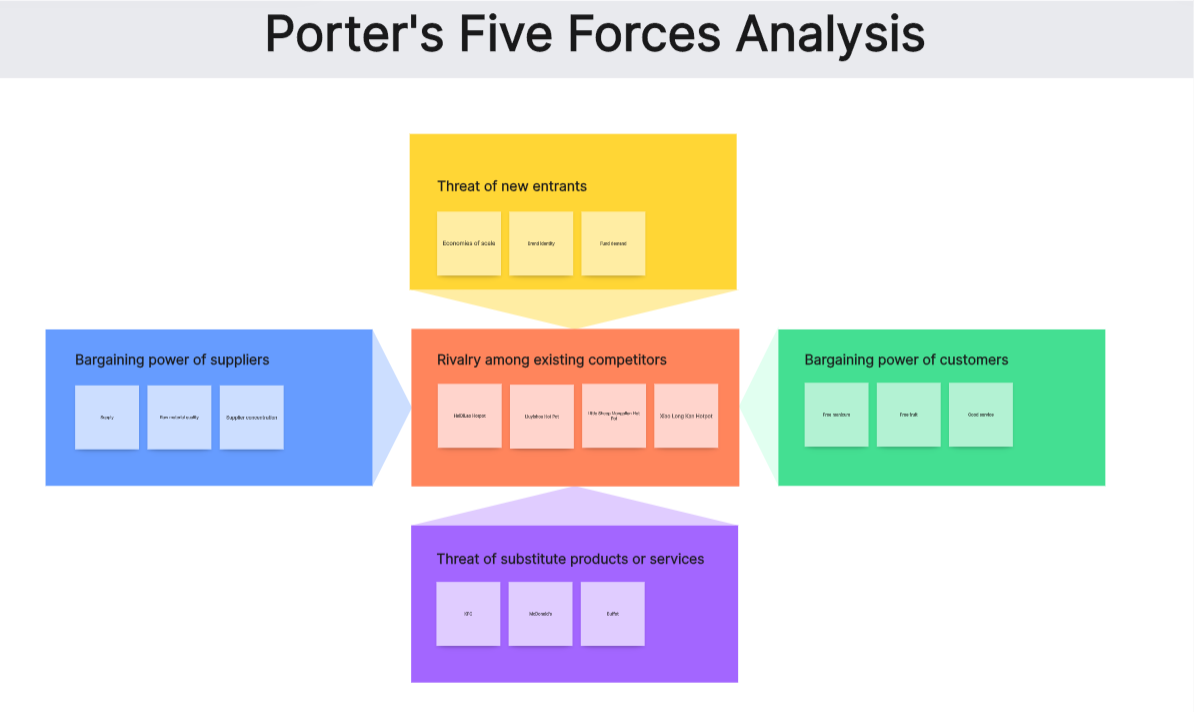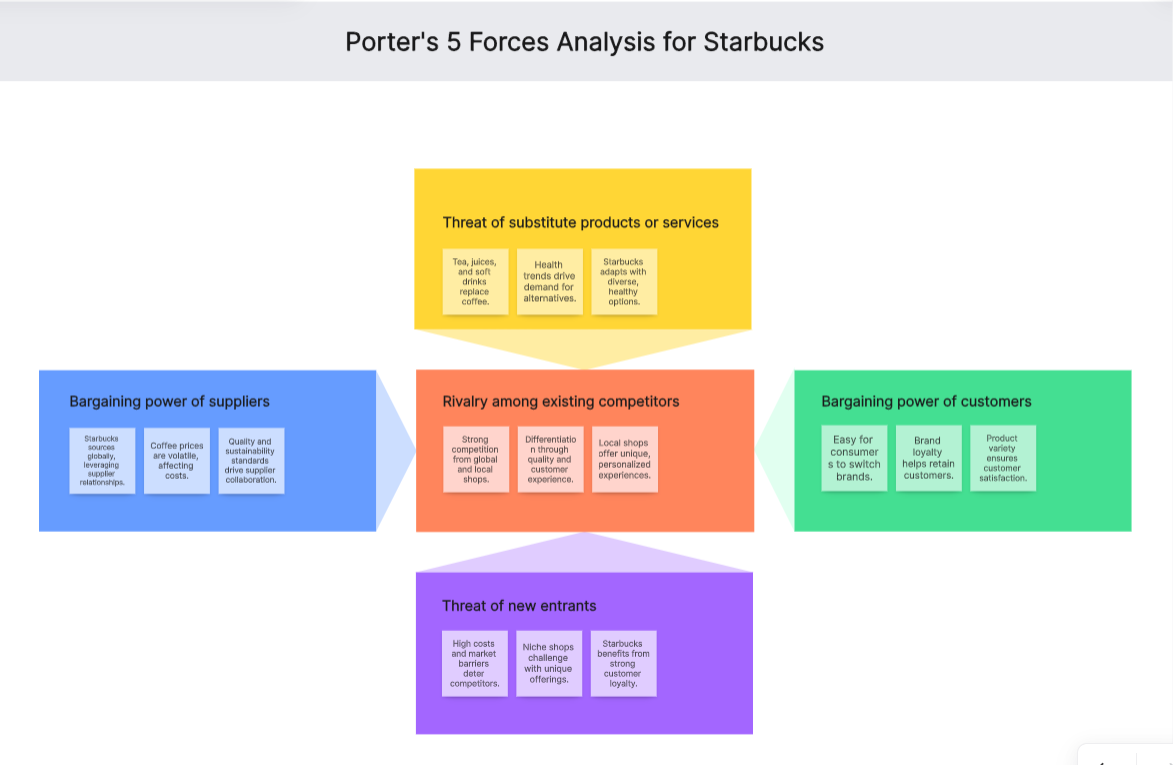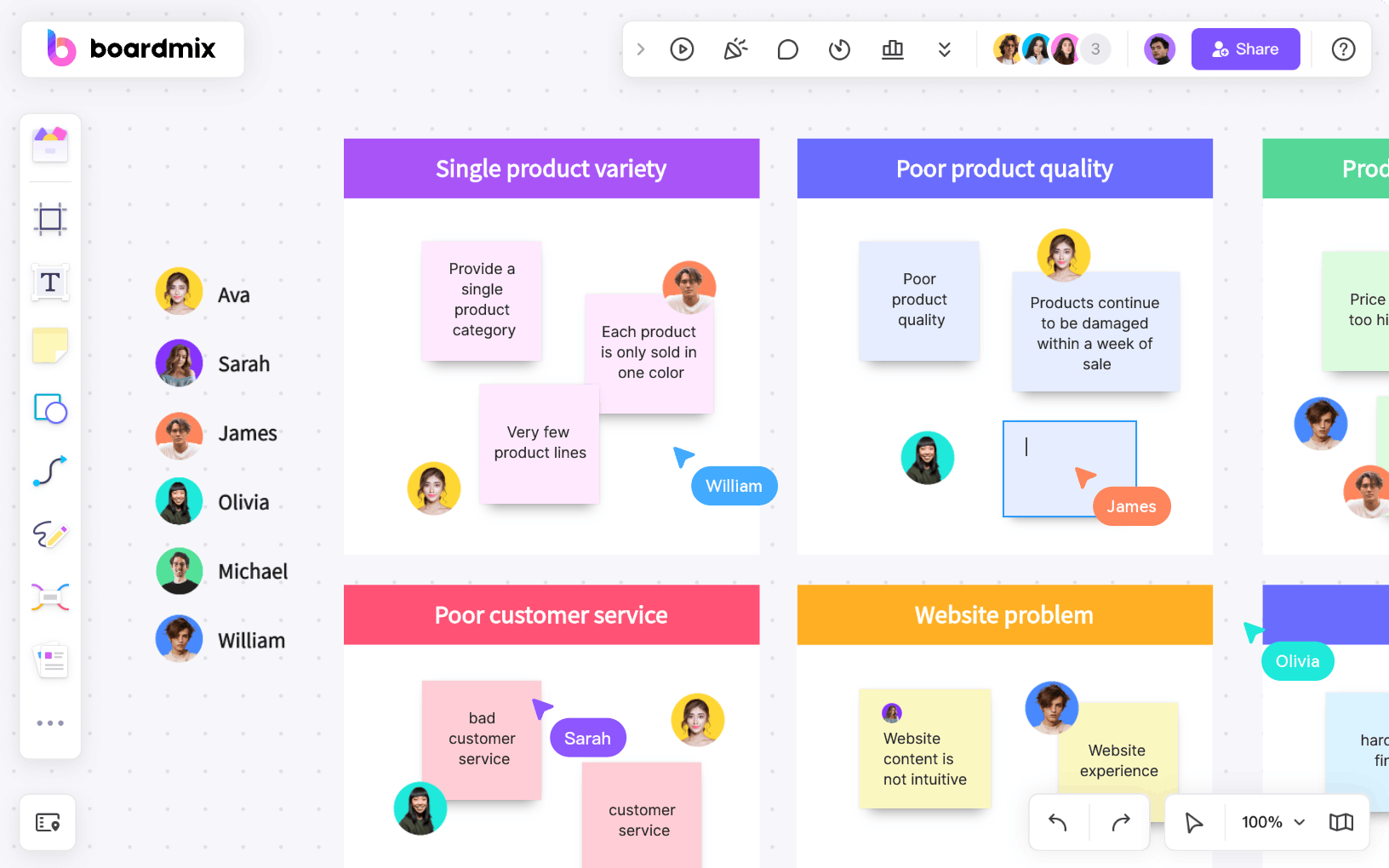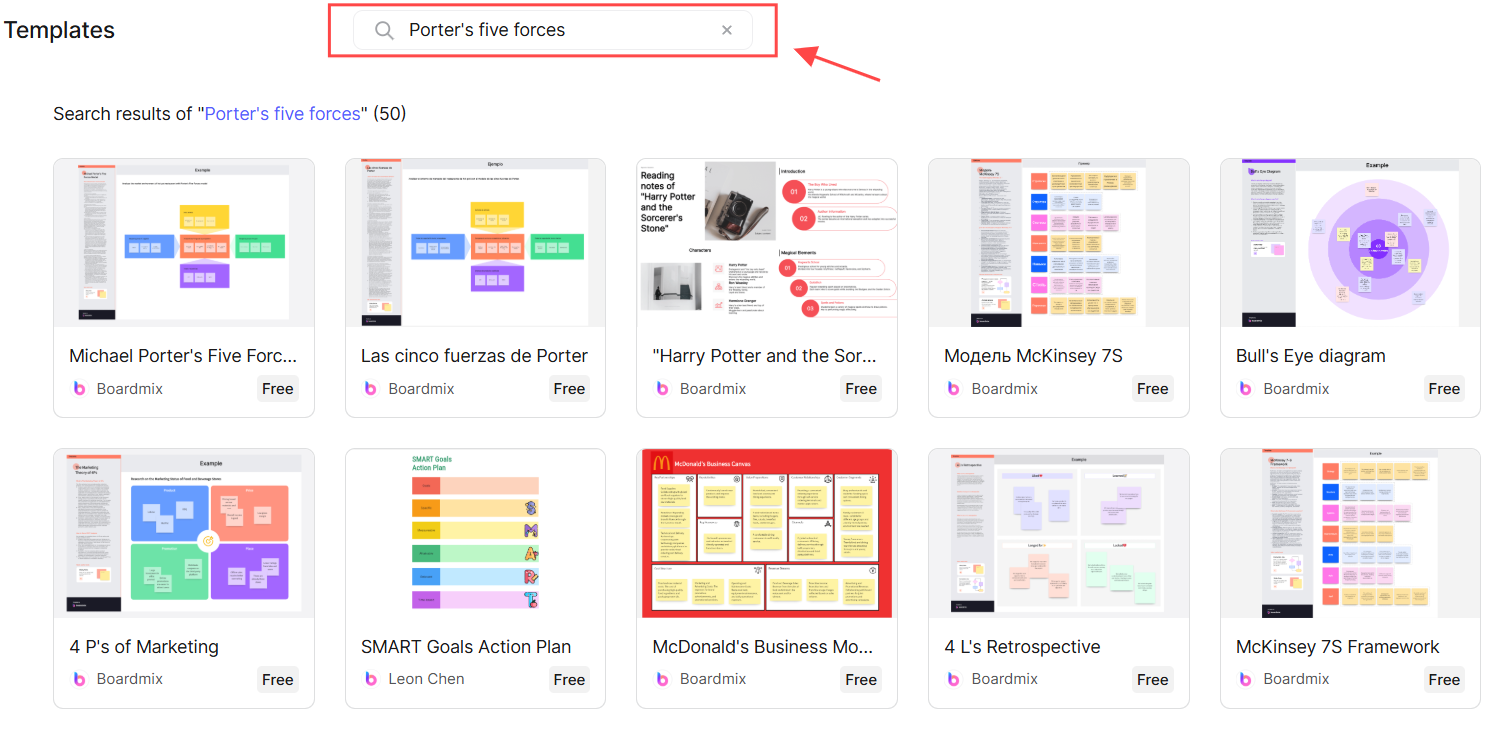Starbucks, a renowned American multinational corporation that has conquered the world with its innovative coffee and customer service concepts, is immersed in a highly competitive and dynamic business environment.
Using Porter's 5 Forces analysis can provide a solid strategic framework for understanding the competitive environment in which Starbucks operates. In addition, we will use the Boardmix template to better visualize this analysis.

Use this Porter's 5 Forces template
Porter's 5 Forces: An Overview
Before we dive into our specific analysis for Starbucks, we must first understand what Porter's 5 Forces are. Developed by economist Michael Porter in 1979, this model helps companies analyze their competitive environment and develop competitive strategies.
The 5 forces are:
- Rivalry among existing competitors: This refers to rivalry among existing companies, which may use various strategies to outperform each other, such as price reduction, product innovation, or increased customer services.
- Bargaining power of suppliers: If suppliers have high bargaining power, they can increase prices or reduce the quality of inputs.
- Bargaining power of customers: Customers who have high bargaining power can pressure companies to lower prices, improve product or service quality, or offer better service conditions.
- Threat of new entrants: Examines the ease with which new companies can enter an industry and become effective competitors. Elements such as barriers to entry, economies of scale, and access to distribution channels can affect this threat.
- Threat of substitute products or services: Products or services that can meet the same needs as yours represent a potential threat to your business. The bargaining power of buyers may be greater if substitute products are available on the market.
Brief introduction to Starbucks
Starbucks Corporation is a multinational coffee company, being the largest coffee chain in the world. From humble beginnings in Seattle, Washington in 1971, Starbucks has grown exponentially and has become globally recognized for its high-quality coffees and the unique experience it offers its customers. Today, it is a global corporation with over 32,000 stores in 80 different markets and an estimated net worth of over $100 billion. Despite its apparent success, it is vital to understand the various factors that influence its market position through Porter's 5 Forces analysis.
Porter's 5 Forces Analysis for Starbucks

Perform Porter's 5 Forces Analysis for Starbucks on Boardmix
Next, we will apply Porter's 5 Forces analysis using the Boardmix template to break down Starbucks' competitive strategy and how the company stays on top in an increasingly saturated market.
1. Rivalry among existing competitors
Rivalry among existing competitors is intense in the coffee shop industry. Starbucks, being the market leader, faces fierce competition from both international chains and local coffee shops. Companies such as Dunkin' Donuts, Costa Coffee, and McCafé are some of the main competitors that also have a strong global presence. On the other hand, local and specialty coffee shops pose a significant threat as they offer unique products and personalized experiences that can appeal to the most discerning customers. However, Starbucks has managed to differentiate itself through its focus on coffee quality, constant innovation in its menu, and an exceptional customer experience.
2. Bargaining power of suppliers
Starbucks sources coffee beans from many different countries, which gives it a high degree of bargaining power vis-a-vis its suppliers. The company has rigorous policies on quality and sustainability and works closely with its suppliers to ensure that these standards are met.
Despite this bargaining power, Starbucks is exposed to fluctuations in global coffee prices, which can be volatile due to factors such as weather and economic policy.
3. Customers' bargaining power
Consumers have high bargaining power in this industry. With so many options available, they can easily switch to another brand if they are not satisfied with the price or quality of the product. Although Starbucks offers a unique atmosphere and a wide variety of drinks and food, customers can find similar products elsewhere.
Starbucks has a high demand for coffee, often at lower prices. However, Starbucks has managed to keep its customers loyal through constant development of innovative products and a strong focus on customer experience.
4. Threat of new entrants
The threat of new entrants in the coffee sector is moderate. Starbucks has a strong market presence, with thousands of stores worldwide and a highly recognized brand. The high costs associated with opening a new coffee shop, coupled with customer loyalty to established brands like Starbucks, deter many potential new entrants.
However, small, independent coffee shops are also growing in popularity, especially among younger consumers who value authenticity and exclusivity. Although these establishments do not pose a direct threat on a large scale, they are changing customer expectations and forcing companies like Starbucks to continually innovate.
5. Threat of substitute products or services
Finally, the threat of substitute products is high for Starbucks. Beverages such as tea, juices, and soft drinks can easily replace coffee. In addition, the growing interest in healthy lifestyles may lead some consumers to seek out less sugary or lower-calorie alternatives. To counter this threat, Starbucks continues to expand its menu to include more healthy and diversified options.
In summary, although Starbucks faces significant challenges in each of Porter's five forces, it has proven capable of staying on top thanks to its effective competitive strategy and constant innovation.
Ideal tool for performing Porter's 5 Forces analysis

Perform Porter's 5 Forces Analysis on Boardmix
Boardmix is an innovative online whiteboard tool that allows teams to collaborate effectively, brainstorm creatively, and plan projects efficiently. It offers a variety of templates that can be used in different contexts, including Porter's 5 Forces analysis.
Porter's 5 Forces is a strategic tool that helps companies understand the competitive dynamics of their industry. By visualizing this model on the Boardmix shared canvas, teams can discuss and strategize in real time, leading to deeper understanding and more effective decision making.
Boardmix sets itself apart from other online whiteboarding tools with its easy-to-use interface, versatile templates, and real-time collaboration capabilities. While it doesn't currently integrate with other ecosystems, its standalone features are robust enough to facilitate productive team collaboration.
Whether you're conducting a Porter's 5 Forces analysis or brainstorming, Boardmix provides you with the tools you need to visualize your thoughts and collaborate with your team.
Here are the steps to use Boardmix by applying Porter's 5 Forces
1) Sign up or log in to boardmix.com and go to the workspace.

2) In the Template Center, choose the Porter's 5 Forces template and click Use.

3) Identify the key players in your organization. Analyze each force and write them all down on Boardmix.
Conclusion
In summary, Starbucks finds itself in a highly competitive and dynamic environment. The Porter's 5 Forces analysis shows that although there are challenges, the company has effectively used its resources and capabilities to maintain its competitive position. Using the Boardmix template, this analysis can be effectively visualized to drive strategic decision making and the formulation of appropriate action plans.
To continue to thrive in this environment, Starbucks will need to continue to monitor and adapt to these forces, while maintaining its focus on constant innovation and delivering exceptional experiences for its customers.









